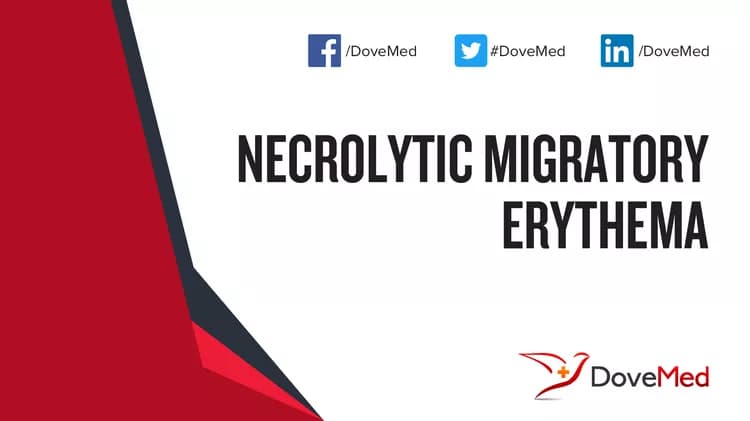What are the other Names for this Condition? (Also known as/Synonyms)
- NME (Necrolytic Migratory Erythema)
What is Necrolytic Migratory Erythema? (Definition/Background Information)
- Necrolytic Migratory Erythema (NME) is a red rash associated with blister formation linked to a variety of conditions, chiefly glucagonoma syndrome
- Other associated conditions include inflammatory bowel disorders, liver disease, and certain malignancies. The cause of development of Necrolytic Migratory Erythema is unknown
- Necrolytic Migratory Erythema is generally seen during adulthood. Any part of the body may be affected; the skin rashes may be present on the limbs, abdomen, and pelvis. In some, the ulcerations may be present on the tongue and lips
- The treatment of Necrolytic Migratory Erythema is dependent upon the underlying condition it is associated with. In case of glucagonoma syndrome, a surgical removal of the glucagon tumor can help resolve the skin condition
- The prognosis of Necrolytic Migratory Erythema is based on the signs and symptoms of the associated condition. It is reported that nearly half of the individuals with NME have a survival period of about 5 years
Who gets Necrolytic Migratory Erythema? (Age and Sex Distribution)
- Most cases of Necrolytic Migratory Erythema are observed in adults, especially adults over 50 years of age
- Both males and females may be affected
- Individuals of all racial and ethnic background can be affected
What are the Risk Factors for Necrolytic Migratory Erythema? (Predisposing Factors)
The risk factors for Necrolytic Migratory Erythema include several systemic conditions and tumors with which it is associated. These conditions include:
- Glucagonoma syndrome: It is a rare condition that occurs due to increased glucagon in blood. It is usually caused by glucagonoma (a slow-growing tumor of the pancreas), which is caused by an increase in glucagon hormone produced by the alpha cells of the pancreas. Glucagonoma syndrome is associated with Necrolytic Migratory Erythema in nearly 70% of the cases
- Inflammatory bowel diseases such as ulcerative colitis and Crohn’s disease
- Autoimmune disorder such as celiac disease
- Malignancies that include lung cancer, hepatocellular carcinoma, and duodenal cancer
- Insulin-secreting tumors
- Liver disease and liver cirrhosis
It is important to note that having a risk factor does not mean that one will get the condition. A risk factor increases one’s chances of getting a condition compared to an individual without the risk factors. Some risk factors are more important than others.
Also, not having a risk factor does not mean that an individual will not get the condition. It is always important to discuss the effect of risk factors with your healthcare provider.
What are the Causes of Necrolytic Migratory Erythema? (Etiology)
The exact cause of development of Necrolytic Migratory Erythema (NME) is unknown.
- It is frequently observed in the presence of glucagonoma syndrome, which is believed to develop from abnormal mutations in certain genes. The glucagon hormone secreting tumor reportedly causes skin inflammation leading to NME, since it reduces albumin protein in the body. The tumor is categorized as a rare pancreatic neuroendocrine tumor (PNET)
- If NME occurs in the absence of glucagonoma syndrome, but with other systemic conditions, it is called pseudoglucagonoma syndrome. Such associated conditions include liver cirrhosis, celiac disease, cancers of the lung and duodenum, and inflammatory bowel diseases
It is important to note that NME is non-contagious and it cannot be transmitted from one individual to another.
What are the Signs and Symptoms of Necrolytic Migratory Erythema?
The signs and symptoms of Necrolytic Migratory Erythema (NME) include:
- The skin lesions are usually red (erythematous) and result in blister formation
- The lesions have irregular border, and are itchy and painful
- Burning sensation may be noted
- The vesicles or fluid-filled blisters may burst causing crust formation. This can lead to secondary bacterial or viral infections
- NME usually occurs around the mouth and lower portions of arms and legs. It can also occur around the abdomen, buttocks, groin area, and perineum
- Around or in the mouth, ulcers may be present on the lips and tongue; the mucosal surfaces may be involved
- Longstanding NME can later lead to (skin) pigment changes, usually hyperpigmentation
Apart from the skin symptoms, glucagonoma syndrome may also cause weight loss, malnutrition, diarrhea, frequent urination, and deep vein thrombosis.
How is Necrolytic Migratory Erythema Diagnosed?
A diagnosis of Necrolytic Migratory Erythema may involve the following:
- A thorough medical history assessment and complete physical examination
- Dermoscopy: It is a diagnostic tool where a dermatologist examines the skin using a special magnified lens
- Wood’s lamp examination: In this procedure, the healthcare provider examines the skin using ultraviolet light. It is performed to examine the change in skin pigmentation
- Tests and exams to diagnose any underlying or associated condition
- Glucagonoma syndrome is diagnosed through blood tests and imaging studies of the abdomen to reveal the presence of pancreatic tumors. These may include:
- Complete blood count (CBC) test
- Amino acid level test
- Liver function test
- Glucose tolerance test
- Blood test to determine glucagon levels
- Radiologic studies to detect glucagonoma or the other causes of Necrolytic Migratory Erytherma
- Glucagon levels by radioimmunoassay (RIA)
- Fasting blood glucose level
- Serum fasting insulin level
- Serum fasting glucagon level
- Serum level of chromogranin A
- Albumin blood test
- Total serum protein with albumin/globulin ratio
- Zinc blood levels test
- Skin biopsy: A skin biopsy is performed and sent to a laboratory for a pathological examination. The pathologist examines the biopsy under a microscope. After putting together clinical findings, special studies on tissues (if needed) and with microscope findings, the pathologist arrives at a definitive diagnosis
Many clinical conditions may have similar signs and symptoms. Your healthcare provider may perform additional tests to rule out other clinical conditions to arrive at a definitive diagnosis.
What are the possible Complications of Necrolytic Migratory Erythema?
Necrolytic Migratory Erythema is a benign condition that does not cause any significant complications. However in some individuals, the following complications may be noted:
- Cosmetic issues resulting in emotional stress
- Secondary bacterial and fungal infection: Continuous itching and scaling of the skin will create skin moistness, providing a suitable environment for bacteria and fungi to grow and thrive
- Glucagonoma syndrome may be associated with multiple endocrine neoplasia 1 (MEN 1), a genetic disorder. The syndrome may also result in blindness and diabetes
- Complications may develop from associated conditions, if any present
How is Necrolytic Migratory Erythema Treated?
The treatment measures adopted for Necrolytic Migratory Erythema (NME) includes undertaking treatment of any associated conditions, such as glucagonoma syndrome. In general, NME is difficult to treat.
The treatment measures for Necrolytic Migratory Erythema may include:
- Surgery to remove the pancreatic tumor causing glucagonoma syndrome, if metastasis has not occurred
- Supportive and symptomatic therapy
- Zinc supplementation
Follow-up care with regular screening and check-ups are important and highly-recommended.
How can Necrolytic Migratory Erythema be Prevented?
- Presently, there are no preventive measures available for Necrolytic Migratory Erythema.
- Undertaking early diagnosis and treatment of any associated condition, such as glucagonoma syndrome, or other malignancies may be beneficial
What is the Prognosis of Necrolytic Migratory Erythema? (Outcomes/Resolutions)
- The prognosis for Necrolytic Migratory Erythema is dependent on the severity of the underlying condition it is associated with. The overall prognosis is typically guarded
- If it is associated with glucagonoma syndrome, then the prognosis is dependent upon the stage of the pancreatic tumor
Additional and Relevant Useful Information for Necrolytic Migratory Erythema:
- Do not pick or pop the blisters, for doing so can affect the healing process and may result in secondary infections
- Cleaning the skin too hard with strong chemicals or soaps may aggravate the skin condition. Care must be taken avoid strong soaps and chemicals that could potentially worsen the condition
- The presence of dirt on the body is not a causative factor for the condition. However, it helps to be clean and hygienic, which may help the condition from getting worse
Related Articles
Test Your Knowledge
Asked by users
Related Centers
Related Specialties
Related Physicians
Related Procedures
Related Resources
Join DoveHubs
and connect with fellow professionals



0 Comments
Please log in to post a comment.